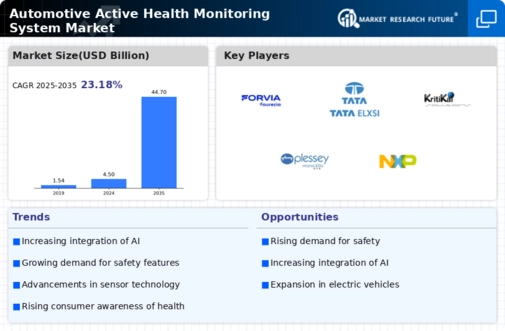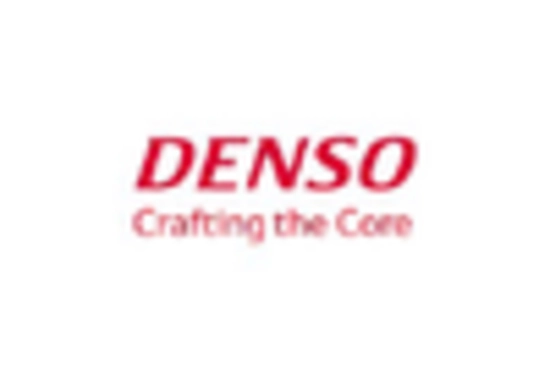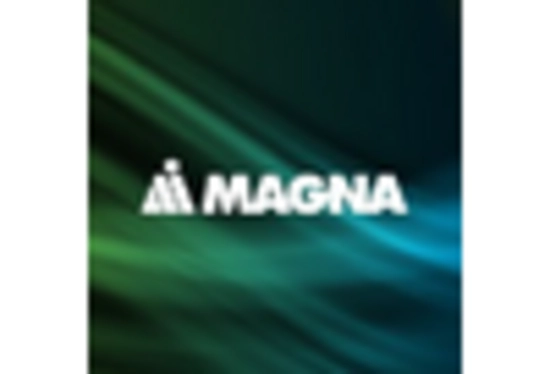Regulatory Compliance and Standards
Regulatory compliance and adherence to safety standards are crucial drivers for the Automotive Active Health Monitoring System Market. Governments worldwide are implementing stringent regulations to enhance vehicle safety and reduce emissions. For instance, the European Union has introduced regulations mandating the installation of advanced safety features in new vehicles. Compliance with these regulations often necessitates the integration of health monitoring systems, which can track vehicle performance and alert drivers to potential issues. This regulatory landscape is likely to compel manufacturers to invest in active health monitoring technologies, thereby fostering market growth. The increasing emphasis on sustainability and safety standards is expected to further accelerate the adoption of these systems.
Rising Adoption of Electric Vehicles
The rising adoption of electric vehicles (EVs) is emerging as a key driver for the Automotive Active Health Monitoring System Market. As the automotive industry shifts towards electrification, the need for sophisticated health monitoring systems becomes more pronounced. EVs require continuous monitoring of battery health, charging status, and overall vehicle performance to ensure optimal functionality. Market data suggests that the EV market is expected to grow at a CAGR of 22% from 2023 to 2030, indicating a substantial increase in demand for health monitoring systems tailored for electric vehicles. This trend highlights the necessity for manufacturers to integrate advanced health monitoring solutions to meet the evolving needs of the market.
Integration of IoT and AI Technologies
The integration of Internet of Things (IoT) and Artificial Intelligence (AI) technologies is a pivotal driver for the Automotive Active Health Monitoring System Market. These technologies facilitate real-time data collection and analysis, enabling vehicles to monitor their health status continuously. The incorporation of AI algorithms allows for predictive maintenance, which can potentially reduce repair costs and enhance vehicle longevity. As per recent estimates, the market for IoT in automotive applications is projected to reach USD 200 billion by 2025, indicating a robust growth trajectory. This trend suggests that manufacturers are increasingly investing in smart technologies to improve vehicle performance and safety, thereby driving the demand for active health monitoring systems.
Growing Consumer Demand for Safety Features
Consumer demand for enhanced safety features in vehicles is a significant driver for the Automotive Active Health Monitoring System Market. As awareness of vehicle safety increases, consumers are more inclined to invest in vehicles equipped with advanced health monitoring systems. These systems provide real-time diagnostics and alerts, which can prevent accidents and ensure passenger safety. Market Research Future indicates that the automotive safety systems market is expected to grow at a CAGR of 8% from 2023 to 2030. This growth reflects a shift in consumer preferences towards vehicles that offer comprehensive safety solutions, thereby propelling the adoption of active health monitoring systems.
Technological Advancements in Sensor Technologies
Technological advancements in sensor technologies are driving the Automotive Active Health Monitoring System Market. The development of sophisticated sensors that can monitor various vehicle parameters, such as engine health, tire pressure, and fluid levels, has become increasingly prevalent. These sensors provide critical data that can be analyzed to predict potential failures and enhance vehicle performance. The market for automotive sensors is projected to grow significantly, with estimates suggesting a value of USD 50 billion by 2026. This growth indicates a rising trend towards the incorporation of advanced sensor technologies in vehicles, which is likely to boost the demand for active health monitoring systems.

















Leave a Comment